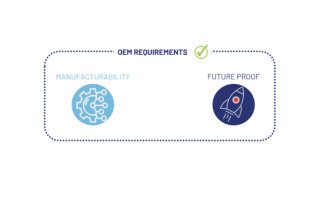Multimedia

The Evolution of Processor Cores, and Embedded World 2024
April 18, 2024
On this episode of Embedded Insiders, we’re discussing the evolution of processor cores, multitasking capabilities, future trends involving processor design, and more with Aaron Frank, senior product manager at Curtiss-Wright Defense Solutions.
Automotive
-
Application Highlight: ADLINK ADM-TJ30 Brings AI to ADAS
April 08, 2024
-
NXP Releases its Open S32 CoreRide Platform Simplifying SDV Development
March 28, 2024
-
Cadence Expands Tensilica Vision Family with Radar Accelerator and New DSPs for Automotive Applications
March 11, 2024
-
Ethernovia Unveils Single and Quad Port, 10G to 1G Automotive PHY in 7nm
March 05, 2024
Consumer
-
Software-Defined Displays: The Secret Sauce for AR Smart Glasses
March 26, 2024
-
Lighter, Clearer, and More Immersive – How the Waveguide – Light Engine Combination Transforms Our View of AR Smart Glasses
March 20, 2024
-
Seeing Beyond Reality: What Are the Key Requirements That Define AR Smart Glasses' Success?
March 18, 2024
-
Wireless Haptic Vest Creates Immersive Experiences for Virtual Reality
March 15, 2024
Debug & Test
-
Embedded Testing Vs Software Testing – Key Differences
April 15, 2024
-
Debug and Analyze with PLS Development Tools During ew '24
February 05, 2024
-
TASKING Supports Arm Architecture for Automotive Development
January 29, 2024
-
Don’t Get Bogged Down in 3rd Party RTOS Code!
January 09, 2024
Healthcare
-
RTLS and Mobile Medical Equipment: How Hospitals Can Prevent Critical Assets from Going Missing
January 15, 2024
-
Engineering Hero: Bringing Prosthetic Arms to Life
December 28, 2023
-
Engineering Hero: The Bright Future of Bionic Limb Prosthetics
December 27, 2023
-
Engineering Hero: Treating Brain Cancer by Targeting Mutations
December 20, 2023
Industrial
-
The Future of Embedded Software Development: The Trend Toward Greater Complexity is Reshaping Product Development
April 22, 2024
-
MediaTek's Vice Chairman and CEO Rick Tsai to Deliver COMPUTEX Keynote
April 18, 2024
-
At embedded world, CEVA Accelerates Innovative Connectivity in MCUs and SOCs for IoT and Smart Edge AI Applications
April 09, 2024
-
Road to embedded world: Ignion Transforms RF Design
April 09, 2024
Networking & 5G
-
Alif Semiconductor Announces BLE and Matter Wireless Microcontroller With Neural Co-Processor for AI/ML Workloads
April 10, 2024
-
Doubling Down on 5G: Integration of Two 5G Modules in One Device
April 10, 2024
-
How Single Pair Ethernet Streamlines Industrial Networks
April 04, 2024
-
Walter, an Open Source WiFi, BLE, LTE-M, NB-IoT, and GNSS Module for Prototyping and Production
April 02, 2024
Processing
-
Embedded Executive: Looking For a Job? Focus on Your Writing, Webster & Webster
April 17, 2024
-
Innominds Leverages Qualcomm to Build New Edge AI Platform
April 15, 2024
-
Embedded Executive: Proprietary Vs. Open AI Ecosystems, Infineon
April 10, 2024
-
Road to embedded world: MIPS Unlocks Power of Edge AI Through Data Movement
April 09, 2024
Software & OS
-
Product of the Week: Parasoft’s C/C++test CT for Continuous Testing & Compliance
April 15, 2024
-
LDRA Released its Domain-Specific Software Productivity Packages for the LDRA Tool Suite
April 12, 2024
-
RTOS Functional Safety Certification – Table Stakes or not?
April 11, 2024
-
Embedded Computing Design Announces PTC Perc Real-Time Java Wins embedded world Best in Show Award
April 09, 2024

























